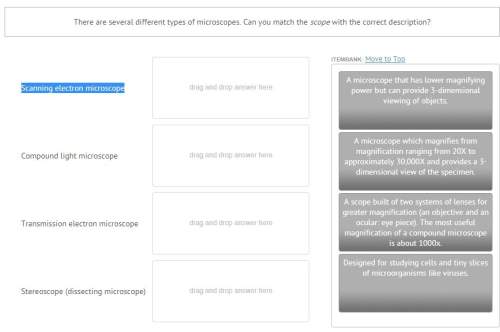
Biology, 28.04.2021 17:10 chewygamerz
Which of the following would not very in a diet between someone from the Ecuador and someone from China
A. Major nutrients
B. Kinds of carbohydrates
C. Amount of food consumed
D. All of these would vary

Answers: 1


Another question on Biology

Biology, 21.06.2019 20:00
With the description of the different cell walls, membranes, and associated proteins set in the students' minds, you now need to introduce them to the idea that the cell wall can also act as a foundation to build things upon. bacterial appendages require a strong foundation that will offer the support needed to move and function in a dynamic world. for example, flagella are long, whiplike protein structures that are used by many gram-positive and gram-negative bacteria for locomotion. in order to function effectively, a flagellum must be firmly anchored to the cell wall. how will you be able to get across the idea that the peptidoglycan cell wall is strong enough to support such a mechanism? with a protein rod that passes through the cell wall and protein rings used to anchor it in the membranes, these basal bodies are the rudimentary biological motors that use atp power to spin the hook and the flagella attached to it. bacterial flagella have a biological motor that spins within the cell wall and is powered by atp. this allows the flagella to spin in a whiplike motion to propel the bacterium.
Answers: 3

Biology, 22.06.2019 00:20
The buildup of sediments where a river empties into a slow-moving or nonmoving body of water is known as a/an
Answers: 1

Biology, 22.06.2019 09:10
Refer to this portion of a dichotomous key for fish identification to answer the question. 1. (a) has a single dorsal fin ® 5 (b) has a double dorsal fin ® 2 2. (a) one fin is spiny, the other is smooth ® 3 (b) one fin is not spiny or smooth ® 4 5. (a) has small fin on back near tail ® 6 (b) has no fin on back near tail ® 7 6. (a) has barbs near the mouth ® catfish (b) does not have barbs near the mouth ® 10 7. (a) tail is asymmetrical ® 8 (b) tail is symmetrical ® 9 10. (a) scales are small ® trout (b) scales are large ® whitefish what is the next step to complete to identify a fish that has a single dorsal fin, no fin on the back near the tail, and no barbs near the mouth? step 2 step 5 step 7 step 10
Answers: 2

Biology, 22.06.2019 10:30
A(n) is a molecule influences the way that a molecule reacts.
Answers: 1
You know the right answer?
Which of the following would not very in a diet between someone from the Ecuador and someone from Ch...
Questions


English, 13.07.2019 06:00


History, 13.07.2019 06:00


Arts, 13.07.2019 06:00


English, 13.07.2019 06:00


English, 13.07.2019 06:00

Mathematics, 13.07.2019 06:00

Mathematics, 13.07.2019 06:00




Mathematics, 13.07.2019 06:00



Mathematics, 13.07.2019 06:00




